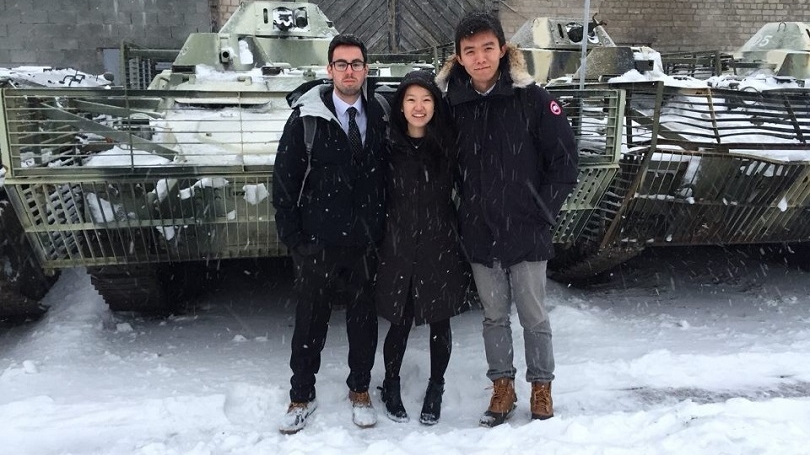
Menu
- Public Policy
- Leadership
- Funding
- News & Events
- About the Center
Back to Top Nav
Back to Top Nav
Back to Top Nav
Back to Top Nav
This past Monday, Professor Shaiko and the Political and Legal Team (Andrew Weckstein, Michelle Li, Kevin Zhang) took a trip to Dnipro, an Eastern city only 100 miles west of the conflict in the Donbas. Although Dnipro is home to nearly 2 million people, the downtown area seemed more like a sprawling town than one of the largest cities in Ukraine. The cold weather, grimy streets, and eerie music on the bus gave Dnipro a somber and Soviet feel.
Our first interview was with a representative from “StopFake,” an organization aiming to identify and refute false information presented in the media. This interview provided an interesting perspective on the “Hybrid War” between Russia and Ukraine and the impact of Kremlin propaganda on the Ukrainian public.
Our next interview was at Dopomoga Dnipra, a local NGO organization that provides social services and supports for those displaced by the conflict in the Donbas. Located in a formerly abandoned building, the run-down infrastructure housed some of the most enthusiastic and passionate civil activists that we have met this trip.
It was inspiring to witness the passion of the Dopomoga Dnipra representatives, but they also expressed some frustration with the international donor community. Citing one anecdote, Bulyshova Gryna lamented that a Swedish Refugee Organization provided training in hand washing and carrying water on one’s head for IDPs from a country that had “sent rockets into space.” It seems that support from International organizations can be out-of-touch with the true needs of local NGOs.
Our next interview was at the Dnipro City Council where we talked to the head of the Department of Social Policy. She provided a valuable perspective on civil society from the government’s point of view.
For our last interview in Dnipro, we visited the headquarters of the Dnipro-1 Militia. Founded during the Maidan protests, this non-governmental organization has fought Russian aggression since the beginning of the conflict. Although we avoided asking the question directly, it is suspected that Kolomoisky, a local oligarch, funds Dnipro-1.
We were given a comprehensive tour of the militia buildings, experiencing everything from their in-house drone factory to their bathroom facilities (exciting!). We were shown their collection of Russian shrapnel and weaponry, displayed as proof that separatists in the Donbas received explicit Russian support. Finally, our group was given a tour of their vehicle and tank arsenal (Kevin says they weren’t technically tanks, but he was practically drooling over them, so I count them as tanks.)
The final video they showed our group opened with the line “Everything is Dnipro-1”— either they need to improve their English translation or this militia has plans for world domination. Either way, Dnipro-1 clearly plays a large role in protecting Dnipro from Russian control, and our time with militia representatives provided an interesting perspective on the role of civil society in Ukraine. Our visit was featured on their website.
Written by Andrew Weckstein '17
This is part of a series where student reflect on their experiences during the field research portion of the PBPL 85:Global Policy Leadership course.